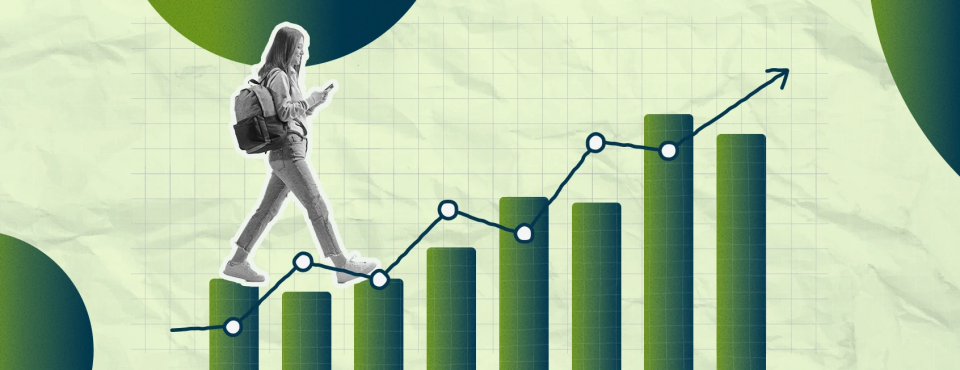
Why Data Is Higher Education’s Most Overlooked Competitive Advantage
Every conversation I have with higher ed leaders seems to start in the same place: competition is tougher than ever. Enrollment pressures, shifting demographics, rising expectations from students — it’s a lot. And in the middle of it all, I see so many institutions sitting on a resource that could help them compete more effectively: their own data.
The truth is, higher ed doesn’t have a data shortage. Colleges and universities already collect enormous amounts of information across their systems. The challenge is knowing how to put it to work in ways that actually move the needle. Too often, that data stays trapped in silos, reduced to static reports, or only pulled out for compliance.
The difference isn’t the data itself — it’s how you use it.
Students expect personalization
Think about how personalized the world around us has become. From the playlists that show up in your music app to the recommendations in your shopping cart, people expect experiences that feel unique and relevant. Students are no different.
A high schooler exploring a summer program and a mid-career professional considering a certificate have very different motivations. Yet both expect a journey that recognizes their goals and helps them take the next right step.
That’s where higher ed data becomes a real advantage. When institutions use it strategically, they can anticipate student needs, personalize outreach, and build relationships that feel relevant, timely, and supportive rather than transactional.
How scattered data becomes a living, actionable picture
Here’s the challenge: most colleges are juggling a patchwork of CRMs, SIS, LMS, and marketing platforms that don’t really talk to each other. Each contains valuable data, but without a way to connect them, the view of the student is incomplete.
This is where the concept of a digital twin comes in. Imagine having a single, dynamic model that reflects each student’s real journey — from first click to graduation. A digital twin takes fragmented data from across systems and turns it into a living, actionable picture.
During a recent conversation with a prospective partner, our team walked through this idea in action. We demonstrated how a digital twin could anticipate critical student moments, unify siloed systems, and make engagement more intentional. The “aha” moment came when leaders realized it wasn’t about another dashboard, but about creating a foundation that turns information into action.
With that kind of visibility, institutions can do things like:
- Spot at-risk students before they disengage.
- Give advisors and faculty the insights to offer timely support.
- See what’s really driving enrollment outcomes.
- Run “what if” scenarios to guide strategy and resources.
That kind of transformation doesn’t just look good on paper — it delivers measurable outcomes.
Real results from using data differently
I’ve seen what happens when institutions make this shift.
I recall one university partner that had been struggling with years of declining graduate enrollment. By unifying their data and creating a clear view across the funnel, they grew spring enrollment by 20% in a single term while re-engaging 120 stop-out students.
Another school was questioning the ROI of their marketing spend. Once they integrated campaign data with enrollment outcomes and student sentiment, they were able to adjust quickly. The result? A 30% increase in online applications and a 46% reduction in cost-per-deposit.
These stories aren’t about magic formulas. They’re about what’s possible when institutions stop letting data sit unused and instead create a digital twin that brings the student journey to life.
Rethinking the role of data
Too often, data is seen and treated as a back-office function. That approach is a liability. I believe higher ed data must be treated as a core part of strategy, student engagement, and institutional health.
If you’re wondering where to start, ask yourself:
- Do we have a clear view of the entire student journey, or are we piecing it together manually?
- Are our engagement efforts personalized, or are they one-size-fits-all?
- Can we make real-time decisions, or are we relying on outdated reports?
- Do our teams have the insights they need to act at the right moment?
If the answer to any of these is “No,” it’s time to rethink your approach to data.
Looking ahead
I’ve spent more than a decade working alongside higher ed leaders, and one thing I know is this: data alone isn’t the advantage. What matters is how you use it to serve students and strengthen your institution.
The colleges and universities that will lead the next era of higher education won’t be the ones with the biggest datasets. They’ll be the ones that create a connected, holistic view of each student — able to anticipate needs, personalize engagement, and act with precision. They’ll be the ones treating data as the engine of innovation, not just a byproduct of operations.
Are you ready to take advantage of your data?
Innovation Starts Here
Higher ed is evolving — don’t get left behind. Explore how Collegis can help your institution thrive.